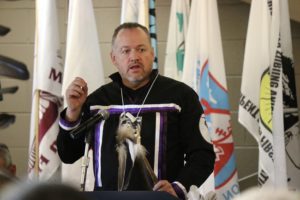Trial verdict opens door to ‘highest form of reconciliation’ says Nipissing First Nation Chief

By Catherine Murton Stoehr
NIPISSING FIRST NATION—Just before Christmas, an Ontario Superior Court Justice in Sudbury delivered a judgment finding for the Anishinabek in the first stage of the Robinson Huron and Superior First Nations’ case against Ontario and Canada for failing to honour their treaty.
Nipissing First Nation Chief Scott McLeod heralded the verdict.
“This decision sets the table to go back to a time of the true spirit and intent of the Treaty and repair our relationship.”
Chief McLeod noted that what follows could be “the highest form of reconciliation”.
The goal of the trial was to figure out what the people who negotiated the treaty meant by it, or in the court’s language, to find “the common intention that best reconciles the parties’ interests’”. Court officials for each of the four parties, Robinson Huron, Robinson Superior, Ontario, and Canada, acted as detectives in a historical recreation of the thought world of a small group of British officials and Anishinabek leaders who met at Bawatang (also called Sault St. Marie) for three days in September of 1850. The court was given the daunting task of determining what the negotiators intended by each clause in the awkwardly worded treaty document, and considering the words and actions related to the treaty, of everyone involved, both before and after its creation, and how all of that evidence combined to produce a common understanding.
The Robinson Huron and Superior treaties are unique in Canada because they contain a promise that annuities would rise as resource revenue increased. This trial was primarily to determine if a reference in the treaty text to a four-dollar cap on individual annuities was intended and understood to be a fixed limit on treaty payments.
Justice Hennessy determined that it was neither.
The judge found that William Robinson, the colonial negotiator who characterized the agreement as transparently “reasonable and just” did not intend the four-dollar cap to be fixed, reasoning that if it had been understood as such by the Anishinabek that they would have rejected the agreement because “it was far less than half of what the other bands received as fixed sum annuities” and “it did not correspond to [the communities’] demand for a share of the future wealth of the territory”. The judge determined that far from capping the annuity, “the Crown promised to increase the collective annuities, without limit” in circumstances where revenues permitted.
The road to this conclusion was not simple and the judge noted “during this hearing, a roomful of skilled lawyers could not agree on how to interpret the Treaties. And they all speak English and were all educated in Common law.” That said, no one offered evidence that Robinson explained the “cap” as a limit on total annuity payments to the Anishinabek so it cannot be considered part of a shared intent.
Many Anishinabek have been wondering, even if there are monies owing, who will decide the amount, or even the process to determine the amount? Ontario and Canada argued that the Crown has sole and “unfettered discretion” to determine how to fulfill their own treaty obligations. In some of the strongest language in a meticulously dispassionate ruling, Justice Hennessy rejected this position saying that allowing the Crown to determine their own treaty obligations was to “invite unending litigation”. Adding that “Since 1850, the Crown has acted with unfettered discretion in their interpretation and implementation of the Treaties, in a way that has seriously undermined their duty of honour”, concluding that the court has the authority to “impose specific and general duties on the Crown”.
While Mike Restoule, the Chair of the Robinson Huron Litigation Trust and long-time proponent of the litigation, has announced that as of now, the Robinson Huron First Nations are “ready, willing, and able to achieve reconciliation”, Canada and Ontario have several options. They could appeal this verdict. Even if it is accepted, they have already raised three specific objections that could limit or cancel out their financial liability. These objections are scheduled to be adjudicated in a second phase of the trial. Should those objections be defeated, a final phase will determine the mechanisms for calculating the Crowns’ obligations, and the nature of those obligations.
Justice Hennessy offered some conclusions with respect to those potential future phases. She rejected one of the Crowns’ objections that a court in the 1890’s had already ruled that the annuity payment cannot rise above four-dollars. This verdict throws out that determination because the Anishinabek were not party to that case.
Further, the ruling determined that taxes collected from companies in the treaty area do not constitute Crown “revenues” and should not be considered in calculating financial obligations. Correspondingly, it was determined that government funded infrastructure such as roads and water systems could not be deducted as expenses from monies owing to the Anishinabek.
The Crown still has options but they are narrowing and their actions are ever more closely watched.
According to Chief McLeod, accepting this verdict is “an opportunity for Canada and Ontario to undo a century and a half of wrongdoings to the Anishinabek people”.


